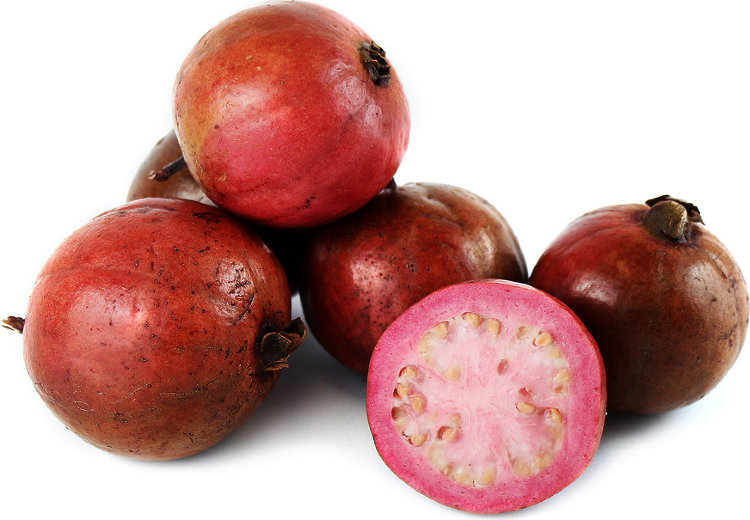- Overview
Botanical name: Ficus carica Family: Myrtaceae
Origin: Tropical Americas Strawberry/Catley Guava Tree in a 3 Gallon Container. Cattley Guava is a fairly slow growing shrub or small tree growing to a height of about 14 feet. The highly fragrant flowers are white followed by small green fruits that turn a bright red when ripe. Fruit size is about 1 1/2 inches. The Cattley can survive temperatures as low as 22F degrees, but prefers warm, humid weather. This guava can be grown indoors or out. Potted, it will only grow to about 5 feet. The shiny dark green leaves make it an excellent contrast to the bright red fruits. Fruits are very sweet. Makes a great shrub or hedge for privacy.
Description
Varieties
Uses
Propagation
Soil Types and Locations
Cultural Practices
Fertilization
Harvesting
Post Harvesting
Description
Neal (1965) describes the guava tree as a low evergreen tree or shrub 6 to 25 feet high, with wide spreading branches and downy twigs. The branches are very strong and highly tolerant to high winds. The leaves are oblong or oval and blunt, 3 to 6 inches long, and feather-veined. The flowers are an inch or more across, the calyx bell-shaped and splitting irregularly, the four to six petals are white, and the stamens are white with yellow anthers (Neal, 1965). The fruit is yellow and lemon-shaped. Some fruits may be brownish yellow. The inside of the fruit has pink or cream-colored pulp and small hard seeds.(1965) indicates that there are a few varieties recognized by Hawaiians that differ only in the fruit produced: the lemon guava (kuawa-lemi) has sour pink pulp, kuawa-momona has bigger seeds and thicker skin, kuawa-ke’oke’o is like the lemon guava but has whitish pulp. The purple strawberry guava and the yellow strawberry guava are a different species, P. cattleianum Sabine and P. cattleianum f. lucidum Degener, respectively.
The cultivars ‘Beaumont’, introduced in 1960 and ‘Ka Hua Kula’, identified in 1972 and introduced in 1978, are the only processing guavas now recommended and grown commercially (Shigeura and Bullock, 1983). Both of these cultivars are high yielding, have a high puree recovery percentage, are pink in color, are somewhat low in acidity, have a pleasant aroma, and are delicate in flavor, and high in total solids. Commercial field trials indicated that ‘Ka Hua Kula’ appears to be a better yielding cultivar. It is also a lower tree with less branch extensions. There are other cultivars that may have potential for later introduction.
Guava is used to produce jams, jellys, and juices commercially. Guava may be eaten raw or cooked. Guavas are an excellent source of vitamin C and also contain iron calcium, and phosphorus.
Despite its use commercially, guava is considered a weed in lower elevations in Hawaii. It is also a serious pest plant in pastures.
Propagation
Guava trees can be nursery propagated by grafting, by budding, by stem cutting (succulent green stems), or by root cuttings (Shigeura and Bullock, 1983). The use of seedlings to establish an orchard is not recommended at the present time; most of these seedlings will not be like the parental type in yield, taste and fruit flesh color.
Seedlings used for grafting or budding may be propagated from seeds from wild guava or clonal trees. There appears to be no differences in the seed source at the present time. Regardless of the seed source, fresh seeds should be from healthy, clean, ripe fruit. The seeds should be thoroughly washed free of any pulpy material and treated with a fungicide to prevent damping-off. If damping-off occurs as the seedlings emerge, both the seedlings and the media surface should be treated with a fungicide. The seedlings may be planted in small containers for later nursery row planting when they are 1-1/2 inches high, or they may be planted in 1 gallon containers for the propagation of larger seedlings for budding or grafting in the future. Grafting or budding can be done when the seedlings are 1/2 inch in diameter and 10 inches above the ground. The seedlings can be grafted or budded by using any acceptable method.
Only strong, succulent greenwood should be used in stem cutting propagation. Shigeura and Matsuyama (1981) recommend the use of a three-node stem cutting with two leafy nodes and a basal node without leaves, or a similar cutting without a basal node. The cuttings should be placed in an intermittent mist chamber with bottom heat and a media temperature of 27 degrees C (80 degrees F). The next step would be to treat the cuttings with a mixture of 2% indolebutyric acid (IBA) suspended in fine dolomitic limestone or insecticidal talc. After 6 to 8 weeks in the mist chamber, the cuttings should be adequately rooted for container transplanting. The transplant containers should be large enough to sustain the cuttings for 4 to 6 months until the resulting plants are ready for field transplanting. Careful handling, a well drained potting soil, and adequate water are necessary at this stage to prevent any damage to the plant.
Propagation from root cuttings is appropriate only if the parent orchard was started from cuttings and not from budding or grafting on a seedling rootstock. This method is not recommended for large nurseries because the amount of available root cuttings is low.
Soil Types And Location
In Hawaii, soil type as a requirement for guava growth is not a major consideration. Guava grows in almost any type of soil.
For fruit production, it is recommended that the guava trees are not planted in areas of high wind. A low windbreak that does not have much lateral growth can be used along the field edges in areas with constant prevailing winds of 10 - 15 miles per hour. Larger orchards extending over 500 feet in length or width will benefit from the use of tall columnar or upright trees on the edges and possibly within the field.
Water supply throughout the production cycle is very important. Irrigation should be used to supply adequate water in any commercial orchard.
Field observations indicate that heavier set fruit are grown in lower elevations. Plants grown at 2000 feet or higher become very erratic depending on temperature differences due to cloud cover. Guava can be economically grown at elevations where pineapple, macadamia, coffee, papaya, mango, and banana are profitably grown. Except for a few areas with a definite southern exposure, most of the areas above 1800 feet are not suitable for growing guavas profitably.
Cultural Practices
The growth habit of the tree, its response to pruning, harvesting method, and other cultural methods should be considered before determining the planting design of any crop. Guava can be pruned and trained into a large, low hanging bush to permit hand harvesting or into a small tree with a single trunk to permit mechanical harvesting. Judicious pruning can maintain the tree radius to about 11 or 12 feet in conjunction with crop cycling. To maximize production in clonal orchards, tree limbs must cover the land area as completely as possible. Pruning and tree training over time can achieve this, but perhaps a better way to this is to initially reduce the blank areas between trees by planting the trees along an equilateral triangle (quincunx) system and at a desired distance between trees rather than on a square system.
The farmer ultimately must make the final decision on spacing between trees. The farmer must consider the production potential of the land based on fertility, availability of water, intensity of sunlight, wind exposure, and other factors. A quincunx design with 25 feet between trees, 21.7 feet between perpendicular rows, 80 trees per acre, and 543 square feet per tree optimizes production. However, a farmer may choose closer spacing with more trees.
A seedling orchard should be planted with an operational area of 24 to 25 feet between rows with trees planted in-row at 8 to 12 foot spacing because of economic reasons. Off-types should be rouged out or topworked when they develop or when cash flow is available for topworking of undesirable trees.
Guava trees should be pruned and trained within the first 3 to 4 months after field planting to increase yield and to reduce the total cost of field operations by eliminating obstacles and branch hazards which allows easier movement around the trees. Pruning is done to train trees to a single trunk and to develop a canopy. Pruning is also used in crop cycling.
Crop cycling is done to keep fruit production constant throughout the year and as a result, increase yield and profit. Crop cycling depends on the natural flowering and fruiting tendencies of the guava tree. Guava trees bear more fruits in certain times of the year, a light crop in the spring and a heavier one in the fall. Production of guava fruit can be cycled by systematic cultural manipulation, for example, pruning, fertilization, irrigation, and defoliation. Each cultural manipulation technique, alone or in combination, can influence flower bud formation by forcing the trees into vegetative growth.
Crop cycling should be initiated immediately after a crop is harvested or when the next cycled crop is desired. The crop harvest will begin approximately 7 months after cycling treatment. As an example, if cycling starts on the first of January, the crop can be harvested on the first of October. The second cycling begins on the first of October and ends on the first of July. Eight separate fields could be separately cycled so that the fruits could be produced around the year.
Fertilization
Presently, there is no data available that would indicate Hawaii soil pH (3.5 to 7.0) has any effect on guava. Unless there is data that indicates pH is a factor in guava production, pH need not be considered for the Hawaii soil types used to grow guavas
During the first few months in the field, guava trees should be fertilized at a 2 to 3 month interval with a complete fertilizer including calcium, magnesium, and other trace elements. Leaf sampling should be done as leaves become available to determine deficiencies. Appropriate fertilizer should be applied to compensate for any deficiencies. At the end of the second year or at the beginning of the third, the trees can then be put into production cycling. If a crop cycling program prevents the use of fertilizer, the fertilizer should be applied after the completion of the current crop as a benefit for the succeeding crop.
Leaf sampling involves taking a sample of leaves and having those leaves analyzed for its elemental components. For guava, the index leaf is the fourth leaf in a whorl of leaves of an actively growing major terminal. The first expanding young leaf in the whorl is considered the first leaf. A 10 leaf sample should be taken from 10 trees with similar appearances in the area.
Harvesting
Currently, guava fruit are hand picked. Guavas require care when being picked and harvest cannot go on for more than 2 to 3 days during the height of the season because of potential losses from insects and overripe fruit.
Post Harvest
The picked fruit should be placed in a cool place away from the sun. To maintain quality, it is best to process the fruits soon after harvest. The puree can be chilled, frozen, or aseptically packaged. If the fruits need to be stored overnight, the fruit boxes should be places in a covered well ventilated area. Clean green fruits can be set aside for later use and ripened with ethophon.rn - Features
weight: 9.99 lbs : - ReviewsThere is no reviews yet...Be the first!
Be the first to write a review of this product!







